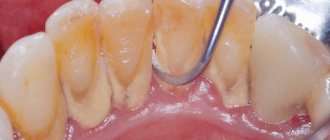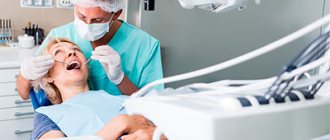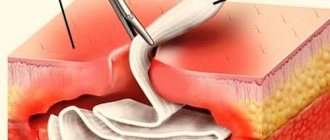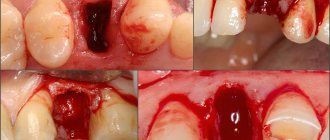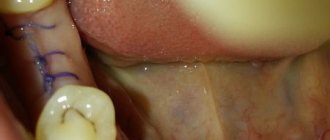The procedure of removing a tooth or tooth root is a common operation in dental surgery. It must be performed by a dentist-surgeon. During tooth extraction, tissue and blood vessels are damaged, leaving a wound filled with thickening blood.
To ensure healing proceeds quickly and there are no complications, you should follow simple recommendations after tooth extraction:
- remove the gauze pad no earlier than 20 minutes after the procedure;
- do not eat for 2 hours;
- Do not eat hot food during the next day;
- do not rinse your mouth;
- do not eat food that is harmful to the oral cavity;
- do not examine the wound using improvised means;
- do not apply compresses;
- Do not overcool, do not overheat, and do not undergo physical exertion for several days.
When following the recommendations, a lot of questions still arise. Let's look at the most common ones.
Everything you need to know about anesthesia!
Smoking is one of the bad habits that has a detrimental effect on the human body. Inhalation of tobacco smoke shortens life and is considered one of the main causes of the development of dangerous diseases, most often incurable.
Smokers are often interested in questions regarding the relationship between their habit and various medical procedures that they have undergone or are about to undergo. It has been proven that nicotine use can cause many times more harm during anesthesia or during tooth extraction than in a normal case.
Medications
Using special medications can significantly increase your chances of quitting smoking. There are three types of medications to treat nicotine addiction:
Nicotine replacement therapy (NRT)
NRTs are the most commonly used medications. They have few side effects and are available both over the counter and by prescription in various forms (chewing gum, tablets, skin patch, inhaler, nasal spray).
NRT medications reduce symptoms of nicotine addiction. Your doctor will help you find the best dosage for you based on your current smoking habits.
Bupropion (Wellbutrin, Zyban). These antidepressants can be used to reduce withdrawal symptoms even if you are not depressed. Common side effects include dry mouth and insomnia (difficulty falling or staying asleep).
Varenicline (Chantix). This medication reduces withdrawal symptoms and, if you start smoking again, may reduce the pleasure you get from nicotine. Common side effects - may cause nausea, dreaming, constipation and drowsiness.
Possible complications during anesthesia
The heart of smokers uses more oxygen during its work than the heart of a non-smoker. Because of this, they often experience pathological symptoms: rapid pulse, arrhythmia and frequent uneven breathing, and in addition, high blood pressure.
As one might think at first glance, the smoker should, on the contrary, receive increased portions of oxygen in the blood, but this is far from the case, because oxygen useful for cells is blocked by carbon monoxide, which enters the body along with cigarette smoke. Against this background, one conclusion suggests itself - the smoker’s heart is exposed to an acute oxygen deficiency.
This condition can result in negative consequences during surgery, which involves the use of anesthesia. In other words, a person has a high chance of developing cardiovascular diseases - coronary heart disease, bradycardia, which can result in cardiac arrest.
Tobacco smoke contains a large amount of tars and toxins that can accumulate in the body. At first glance, this has nothing to do with anesthesia, but precisely because of this effect, smoking often causes an unpredictable reaction of the body to anesthesia drugs, due to disruption of the body's enzyme systems.
When performing an operation using deep anesthesia, the patient undergoes tracheal intubation. For people leading a healthy lifestyle, it is absolutely safe, but in a smoker it can cause laryngeal spasm, which can lead to respiratory arrest. Consequences after anesthesia can be pneumonia, bronchitis, heart failure. Against the background of everything, smokers experience the development of purulent and inflammatory processes.
To reduce the risk of complications, smokers should carefully prepare for elective surgery. The main thing is to quit smoking 1-1.5 months before the expected date of surgery.
If the operation is emergency, such a patient may require an increased dose of anesthetics, which in turn will affect the duration of the recovery period.
Smoking and surgery
One of the main pieces of advice the surgeon gives to all his patients concerns abstinence from any bad habits, both before and after surgery. At least until the final consolidation of the results of the surgical intervention.
Smoking has a pronounced effect on the vascular system of the entire body. Under the influence of tobacco smoke, they narrow, resulting in a deterioration in blood supply in certain areas of the body. A healthy person may not notice such changes, but being in a state of recovery after anesthesia, when the immune system is still weak, the body reacts sharply and clearly to any dysfunction.
Nicotine and carbon monoxide (substances contained in cigarette smoke) have a slowing effect on blood circulation and inhibit the connection of hemoglobin with oxygen. Against the background of difficult circulation, blood begins to “stagnate” in the vessels, and most often this happens in places that have undergone surgery. The body tries to heal itself and sends blood rich in biologically active substances to the damaged areas.
Stagnant processes can cause thrombosis or even tissue necrosis, due to the fact that cells do not receive enough oxygen and nutrients.
Nervous system. Brain
Smoking forms an addiction to the process; nicotine affects receptors, and through them neurons. Apparently, it is the interference of nicotine in neural connections that leads to the fact that in smokers:
- the reaction to preoperative premedication (drug preparation) is weakly expressed, and this complicates the course of the preoperative period and the early stage of induction of anesthesia;
- the pain sensitivity threshold is higher, which worsens the course of the postoperative period;
- The period of pre-anesthesia preparation and the anesthesia itself (mostly intubation) is more difficult.
Another effect of nicotine on VSN is the activation of adrenaline production, which leads to bright or smoothed signs of a panic attack, and over time causes disturbances in the physiology of the central nervous system and vascular tone, leading to the formation of arterial hypertension
But the cells of the vomiting center “trained” by smoking facilitate the course of the postoperative period by reacting weaker or not at all to the vomiting-stimulating effect of anesthesia drugs.
Smoking after tooth extraction
When there is a need for tooth extraction, heavy smokers are concerned about smoking after the procedure. They ask the doctor whether it is possible to smoke, and if not, then for what reasons and for how long.
Smoking after oral surgery is prohibited for several reasons:
- Due to smoking, a greenhouse effect occurs in the mouth, and the area that has undergone medical intervention must be kept cold. Against the background of warming up, the gums after tooth extraction may begin to bleed, and the wound will take much longer to heal.
- Tobacco smoke contains radioactive substances (polonium 210, radium 226, lead 210). These elements accumulate in tobacco leaves and enter the lungs during inhalation. Cigarettes with a filter slightly reduce their concentration, but in the postoperative period, the exposed tooth socket is the place most susceptible to negative effects. Smoking can cause tumors and further damage to gum and jaw tissue.
- Cigarette smoke, even the lightest cigarettes, contains tars that settle on the mucous membranes of the oral cavity. The unprotected area after surgery will be irritated by them and will take much longer to heal. Initially, this goes unnoticed, because nicotine contains an alkaloid - anabasine, which has an analgesic effect, but the consequences in the future can become the most unpredictable, from tissue suppuration to a long period of healing of the tooth socket.
Considering these reasons, doctors advise refraining from smoking for at least 24 hours after tooth extraction to prevent possible complications and relapses.
BENEFITS OF QUITTING SMOKING
There are many physical and psychological benefits to stopping tobacco use after a cancer diagnosis, including:
- Increased life expectancy
- More chances for successful treatment
- Reduce serious side effects from all cancer treatments, including surgery, chemotherapy and radiation therapy
- Faster recovery after treatment
- Reducing the risk of secondary tumors
- Reducing the risk of infectious complications
- Easy breath
- More energy
- Better quality of life
On the other hand, continued use of tobacco carries the following risks:
- Increased life expectancy;
- Shortening life;
- Less chance of successful effective treatment;
- More complications after surgery associated with disruption of the heart and lungs, slower recovery;
- More side effects from chemotherapy, such as infections, fatigue, heart and lung problems, weight loss;
- Additional side effects from radiation therapy, including dry mouth, mouth ulcers, loss of taste, and bone and soft tissue problems;
- Increased likelihood of relapse (cancer returning after treatment);
- Increased risk of other serious diseases related to heart and lung problems, or a second tumor.
Smoking after wisdom tooth removal
Removal of a figure eight, or wisdom tooth, is considered one of the types of full-fledged surgical intervention, after which stitches are applied. On average, during the postoperative period it is advised to refrain from smoking for 10 days, in order not to interfere with normal tissue restoration.
The minimum period of abstinence is considered to be 2 days, because during the first 48 hours, smoking is almost 100% likely to lead to inflammation of the soft tissue of the gums, causing suppuration of the surgical sites or suture dehiscence.
If you have a strong craving for smoking, it is recommended to use special anti-nicotine patches, which will replenish the nicotine deficiency in the body and reduce the need for cigarettes.
Smoking a hookah or electronic cigarettes during the postoperative period is also contraindicated, because they cause a greenhouse effect, and this is one of the reasons for complications.
Smoking is a major medical and social problem.
It turns out that, in addition to the fact that smoking has an adverse effect on the human body, it also significantly affects the course of anesthesia, increasing the risk of developing various complications of anesthesia.
Why is anesthesia dangerous for people who smoke?
Nicotine and carbon monoxide are the main culprits of anesthesia complications in smokers. Inhaling nicotine when smoking releases large amounts of adrenaline in the body, which causes increased heart rate and increased blood pressure. But in order to beat frequently and maintain unusually high blood pressure, the heart needs to work harder and, therefore, receive more oxygen. However, a person who smokes, on the contrary, receives even less oxygen. This happens because carbon monoxide inhaled during smoking blocks hemoglobin, which is the main carrier of oxygen in the body. Thus, the smoker’s heart experiences a large oxygen deficiency, especially pronounced during anesthesia. That is why smokers during anesthesia are at significant risk of developing cardiovascular complications.
Smoking significantly alters the functioning of the body's enzyme systems, which are responsible for breaking down external toxins and drugs. Therefore, administering anesthesia to smokers is associated with some unpredictability in the action of the drugs used for anesthesia.
Considering that the lungs of smokers are a target for constant exposure to harmful substances contained in cigarettes, anesthesia in smokers is associated with a high risk of developing respiratory complications. Patients who smoke have a 5 times greater risk of developing complications such as atelectasis, bronchitis and pneumonia. In addition, during anesthesia, the airways of smoking patients become very susceptible to any external influences. Thus, tracheal intubation often causes a sharp closure (spasm) of the lumen of the larynx (laryngospasm) and bronchi (bronchospasm); these disorders can pose a threat to the patient’s life.
What to do if you are planning to undergo anesthesia and you smoke?
It is necessary to completely normalize the level of nicotine and carbon monoxide in the smoker’s blood so that during anesthesia the risk of cardiovascular complications is significantly reduced. To do this, it is necessary that at least 24 hours pass between the start of anesthesia and the last cigarette smoked. To reduce the risk of respiratory complications, the patient must completely quit smoking, and at least 2 months must pass from the last cigarette smoked to the time of anesthesia.
Interestingly, the best results, in terms of the risk of developing post-anesthesia complications, are observed in patients who either quit smoking more than 2 months ago, or their last cigarette was smoked 24 hours before anesthesia. Paradoxically, patients who quit smoking several days to a month before anesthesia have an even greater risk of respiratory complications than patients who did not quit smoking. These patients cough up sputum very poorly, and moreover, it is produced in larger quantities than usual. All this predisposes to the development of bronchitis and then pneumonia after anesthesia.
Providing anesthesia to smokers has a number of specific features. Thus, during anesthesia, patients who smoke require the administration of large doses of anesthetics and narcotic analgesics. After anesthesia, smoking patients often need to breathe oxygen, as impaired lung function begins to make itself felt. Also, after anesthesia, smokers have an increased need for painkillers; these drugs are administered more often and in larger doses. To prevent respiratory disorders, smoking patients after anesthesia should do breathing exercises; in addition, a course of chest massage and other physiotherapeutic procedures is recommended.
Given the high risk of developing complications from the lungs and heart, patients who smoke should avoid anesthesia and, if possible, choose regional (spinal, epidural) or local anesthesia.
For general or local anesthesia, anesthetic drugs are used. All medications have a number of side effects. To reduce the risk of complications, it is important to adhere to the rules recommended by the anesthesiologist.
Nicotine and alcohol are incompatible with anesthetics. They can affect the course of anesthesia in different ways. In some cases, the anesthetic medicine will have a weak effect on the body, but may enhance the effect of anesthesia.
After surgery, some patients do not know whether it is possible to smoke (ordinary cigarettes or electronic cigarettes, hookah), drink alcohol (beer, wine, etc.)? And how soon can I use it?
You should talk to your doctor about your lifestyle after surgery.
Features of anesthesia in smoking patients
Introduction
It would probably be more correct to title this article “Smoking and the perioperative period,” since smoking not only complicates the course of anesthesia, but also makes the surgical intervention itself more problematic.
In addition, there is another paradox here that needs to be mentioned. Smoking is a factor that leads people to undergo surgery, that is, smoking itself is a cause of surgery. Most patients who undergo chest surgery are smokers. The vast majority of patients undergoing coronary artery bypass grafting or vascular surgery on the extremities are also smokers. Smoking is a factor that negatively affects the outcome of surgery during vascular, cardiac and colorectal operations. During plastic surgery, smoking is one of the risk factors for rejection of the transplanted tissue. Smoking causes chronic inflammation of the airways, coughing, increased mucus production, and ultimately chronic obstructive pulmonary disease. Smoking, sooner or later, leads not only to damage to the respiratory system, but also to other systemic effects. A clear relationship has been proven between smoking and diseases such as cancer of the lung, stomach, bladder and larynx. Many studies have proven that both active and passive smokers have many more complications of anesthesia (especially during induction and awakening) than non-smoking patients. It should be noted that passive smokers are also at risk and have an increased likelihood of adverse events during anesthesia.
On average in Europe, smokers make up approximately 20-25% of the population. Interestingly, 33-35% of surgical patients are smokers.
Several studies have compared the incidence of reintubation, laryngospasm, bronchospasm, aspiration, hypoventilation, and hypoxemia during anesthesia in smokers and nonsmokers. The probability of these complications occurring in smokers was 5.5%, in non-smoking patients - 3.25%. Smoking patients with concomitant obesity are at greater risk. The highest risk group, in terms of the risk of postoperative complications and the likelihood of admission to the intensive care unit, are patients who smoke more than 50 blocks of cigarettes per year.
Systemic effects of nicotine and carbon monoxide
The cardiovascular system
Tobacco smoke contains a huge amount of harmful toxic substances, but the greatest negative effect is caused by the nicotine and carbon monoxide it contains.
Nicotine causes excessive activation of the adrenal medulla, resulting in the release of large amounts of adrenaline into the blood. With chronic exposure to nicotine, this causes a restructuring of the autonomic nervous system and leads to the development of arterial hypertension. In addition, nicotine has a direct stimulating effect on the sympathetic nervous system, which results in an increase in heart rate, blood pressure, peripheral vascular resistance, myocardial contractility and, ultimately, an increase in myocardial oxygen demand. Nicotine also increases the content of intracellular calcium, which in the case of myocardial ischemia further enhances damage to cardiomyocytes. After smoking one cigarette, the concentration of nicotine in the blood plasma reaches 5-50 ng/ml. The half-life of nicotine is 30-60 minutes. Thus, in a smoking person, an improvement in the ratio of oxygen delivery/consumption by the myocardium can occur only if he gives up smoking for a period of at least 3-4 hours.
Nicotine has a pro-inflammatory effect, increases the likelihood of endothelial damage, and has a negative effect on blood lipid metabolism - all this contributes to the development and progression of atherosclerosis of the coronary arteries. Therefore, it is not surprising that smoking is one of the significant risk factors for coronary heart disease, arterial hypertension and peripheral vascular diseases.
The increased level of blood catecholamines observed in smokers causes a more pronounced sympathoadrenal response to tracheal intubation and surgical trauma. Increased myocardial oxygen demand and reduced oxygen delivery to the myocardium increases the likelihood of myocardial ischemia, arrhythmias and other cardiovascular complications during surgery and anesthesia.
Carbon monoxide, like nicotine, also has a negative effect on the smoker's body. First of all, carbon monoxide interacts with myoglobin and mitochondrial cytochrome oxidase. Inactivation of cytochrome oxidase enzymes of the heart muscle leads to a decrease in oxygen utilization by cardiomyocytes, chronic hypoxia and, ultimately, a decrease in myocardial contractility. The half-life of carboxyhemoglobin is determined by the adequacy of pulmonary ventilation and, on average, at rest is about 4-6 hours (slightly longer in men than in women).
Respiratory system
Smoking has a negative effect on gas exchange in the lungs and on the oxygen transport function of the blood.
Smoking increases the production and changes the consistency of mucus in the respiratory tract (mucus becomes more viscous and less elastic). The cytotoxins contained in tobacco smoke destroy the ciliated epithelium of the respiratory tract, which disrupts mucociliary clearance and the removal of mucus from the tracheobronchial tree. In addition, disruption of the structure of the ciliated epithelium leads to increased reactivity of the respiratory tract.
Smoking causes chronic inflammation, swelling, narrowing of the airways - that is, a whole group of processes leading to an increase in the volume of closure of the lungs. Chronic inflammation also causes increased production of proteolytic enzymes, which destroy the elastic structure of the lung tissue and lead to pulmonary emphysema.
It has been proven that smoking significantly increases the risk of pulmonary infection, so 25-30% of smokers suffer from chronic bronchitis.
When performing spirometry on a smoking patient, the most common diagnosis is a violation of the respiratory function of the obstructive type, a decrease in forced expiratory volume in 1 second (FEV1). It should be noted that normally, with age, non-smokers experience a gradual decrease in FEV1 - by about 20 ml per year, while in smokers, FEV1 decreases much more intensely - by about 60 ml per year.
In smoking patients, the level of carboxyhemoglobin in the blood can reach 15%. The amount of carbon monoxide in a smoker's blood greatly depends on the quality of tobacco and the frequency of smoking. Carbon monoxide binds to hemoglobin at the same site as oxygen, but hemoglobin's affinity for carbon monoxide is 250 times greater than its affinity for oxygen. As a result, there is little space left for hemoglobin to bind to oxygen, and the blood carries much less oxygen - the hemoglobin dissociation curve shifts to the left. Giving 100% oxygen significantly speeds up the process of removing carbon monoxide from the blood. Thus, when breathing 100% oxygen, the half-life of carbon monoxide is 40-80 minutes.
Thus, we see that smoking has a multifaceted effect on human breathing - it disrupts ventilation, gas exchange and the transport of oxygen to tissues.
With regard to anesthesiological features, the increased reactivity of the respiratory tract observed in smoking patients increases the risk of developing laryngo- and bronchospasm, in addition, smoking patients have a poor response to bronchodilator therapy. Premedication with anticholinemetic drugs, sedatives and bronchodilators reduces the risk of laryngobronchospasm.
Smoking patients have a 6 times greater risk of developing postoperative respiratory complications (primarily atelectasis and pneumonia). It is necessary to have increased vigilance in terms of timely diagnosis and treatment of possible respiratory complications in this category of patients.
Nervous system
Nicotine acts on several subtypes of nicotinic acetylcholine receptors. Impact on the first type leads to the activation of dopaminergic neurons responsible for the formation of feelings of pleasure. Long-term smoking causes certain changes in the central nervous system, leading to the formation of nicotine addiction. A person who smokes needs constant nicotine stimulation, since in case of a sudden interruption of smoking there is a very high probability of developing nicotine withdrawal syndrome (withdrawal syndrome).
Nicotinic acetylcholine receptors are also involved in pain modulation. It has been proven that long-term smokers who have developed tolerance to nicotine are more sensitive to pain. If these patients are given intranasal nicotine (in liquid form) in the recovery room, the need for analgesia will be much less.
Digestive system
Smoking does not affect the volume or acidity of gastric contents. Smoking is known to relax the gastroesophageal sphincter, but within a few minutes after smoking, the sphincter tone returns to normal. The claim that patients who smoke are at greater risk of aspiration is not supported by scientific research.
The immune system
There is evidence that people who smoke have impaired cellular immunity, which leads to an increased risk of developing infections and malignancies. It has also been proven that smokers have slightly reduced production of immunoglobulins and lower leukocyte activity.
Blood cells and the hemostasis system
Over time, people who smoke develop polycythemia and, as a result, thickening of the blood. In addition, it has been proven that fibrinogen concentration and platelet activity increase in smokers. These factors suggest that smokers are susceptible to a greater risk of arterial and venous thrombosis.
Smoking and withdrawal symptoms
The development of withdrawal syndrome is associated with a decrease or complete elimination of nicotine. Withdrawal symptoms may occur within a few hours after quitting smoking or last for several weeks. In addition to mental disorders (depression, agitation, insomnia), nicotine withdrawal syndrome also has disturbances in other systems - the gastrointestinal tract (increased appetite), the respiratory system (bronchorrhea), and the cardiovascular system.
Postoperative nausea and vomiting
Chronic smoking leads to desensitization of the central nervous system, resulting in a lower incidence of postoperative nausea and vomiting.
Smoking and postoperative wound healing
It is known that smoking patients have a greater risk of complications associated with postoperative tissue healing and this is understandable. Smokers have a higher likelihood of systemic vascular damage (and therefore impaired oxygen delivery to tissues), a higher risk of wound infection (due to impaired immune system), and the existing hypercoagulation often leads to thrombosis in the microcirculation system, aggravating the already poor tissue oxygenation. In addition, nicotine is a potent inhibitor of fibroblast and macrophage proliferation.
Smoking affects bone metabolism, and there is a clear link between osteoporosis, poor fracture healing and smoking.
Several randomized studies have shown that after knee, hip, colorectal or plastic surgery, the risk of surgical complications, including difficult-to-treat wound infections, is 8-10 times higher in smokers than in non-smokers.
The effect of smoking on the metabolism of drugs used in anesthesia
There are about 4,800 chemicals released in tobacco smoke. The most studied of these are nicotine and carbon monoxide.
Smoking patients have an increased metabolism of inhalational anesthetics. Although this does not increase the patient's intraoperative need for inhalational anesthetics, it does result in higher concentrations of toxic metabolic products of inhalational anesthetics. There are publications that talk about the development of liver or kidney failure in smoking patients after the use of inhalational anesthetics. However, it remains quite difficult to prove to what extent smoking is responsible for the development of these complications.
Smoking affects liver enzymes, which leads to accelerated metabolism of certain drugs. Chronic smokers require large doses of opioids (especially pethidine and morphine). It has also been proven that smoking patients require large doses of steroid muscle relaxants.
Preoperative examination and preparation of smoking patients for anesthesia
In general, the scope of preoperative examinations of a smoking patient differs little from existing standards and includes anamnesis, physical and instrumental examinations. The choice of premedication method and the issue of quitting smoking before a planned operation has some peculiarities.
When collecting anamnesis, it is important to find out how long and how many cigarettes a day the patient smokes. During the physical examination, it is necessary to pay attention to signs of chronic hypoxia. In patients with chronic obstructive bronchitis, it is important to perform a chest x-ray (to identify signs of chronic infection, emphysema, cor pulmonale), as well as spirometry with bronchodilators (to determine the reversibility of obstruction).
Stop smoking before surgery
After smoking a cigarette, the hemodynamic effects of tobacco smoke persist for approximately one hour. It has been proven that stopping smoking 12 hours before surgery increases the body's functional capabilities by 10-20%. It has been clearly proven that stopping smoking 12-24 hours before surgery leads to the removal of carbon monoxide from the body, which significantly improves the oxygen transport function of the blood. Stopping smoking for 12 to 48 hours improves myocardial oxygenation, inotropic function, and reduces the likelihood of ischemia and arrhythmic events. Prolonged smoking cessation improves mucociliary clearance and reduces small airway reactivity. In order to reduce sputum production and cough, it is necessary to abstain from smoking for a period of several weeks. Airway reactivity completely decreases only after 10 days after stopping smoking. If you quit smoking a month before surgery, then, oddly enough, the risk of pulmonary postoperative complications increases. Stopping smoking 5-6 months before surgery reduces the risk of all postoperative complications associated with smoking.
Thus, stopping smoking a few days before surgery will most likely not give any positive effects, and may be complicated by the development of withdrawal symptoms. It is considered optimal to quit smoking several months before the proposed surgical intervention. When stopping smoking, to prevent withdrawal symptoms, it is recommended to use nicotine patches, which are a good alternative to the nicotine that comes with smoking.
Premedication
It is considered advisable to include inhaled bronchodilators, steroids, anticholinemics and sedatives in premedication for smoking patients.
Features of anesthesia in smoking patients
Regional anesthesia methods have undoubted advantages in smoking patients, as they reduce the likelihood of postoperative pulmonary complications, the risk of deep vein thrombosis, improve microcirculation and allow early mobilization of the patient. Paradoxically, smoking is a factor accelerating the postoperative mobilization of patients, since the need for smoking does not stimulate them to bed rest: feeling an irresistible craving, patients try to “jump out” of bed as soon as possible.
When performing induction of anesthesia, it is necessary to remember that smoking patients have increased respiratory tract reactivity and a reduced oxygen reserve in the body, so these patients need good preoxygenation and deep induction, which involves the administration of a good dose of opioids. Sometimes, to reduce the reactivity of the respiratory tract, irrigation of the trachea and larynx with local anesthetics is used. When performing anesthesia, smoking patients should avoid the use of histamine-releasing medications, as they can provoke bronchospasm (mivacurium, atracurium). It is also undesirable to use anesthetics that have a stimulating effect on the cardiovascular system (ketamine, sevoflurane). To avoid an excessive cardiovascular response, vasopressors should be used in lower than usual doses.
We should not forget about the increased activity of liver enzymes in smoking patients. When administering anesthesia to smoking patients, large doses of opioids and steroid muscle relaxants are very often required.
Tracheal extubation in smoking patients should only be performed against a background of good analgesia, clear consciousness and normal muscle tone.
Features of the postoperative period
In the postoperative period, the use of nicotine patches should be continued, since the development of withdrawal syndrome leads to an increased need for analgesics. The pain relief provided must be very good. For thoracic and abdominal operations (on the upper floor of the abdominal cavity), the possibility of using epidural anesthesia should always be considered, and for orthopedic operations, prolonged conduction anesthesia.
To improve ventilation and coughing in the postoperative period, smoking patients need to begin physiotherapeutic treatment as early as possible. Consider the use of humidified oxygen, as well as regular inhaled bronchodilators and inhaled steroids. All this can significantly improve the drainage and ventilation function of the lungs of a smoking patient.
Alcoholic drinks after surgery
Medicines are eliminated from the body after a certain time. During the first day - the main part of the medicine, and over the next days or weeks the residual concentration of the anesthetic substance. The elimination period depends on the type of anesthetic and dosage, as well as the condition of the body. Therefore, drinking alcohol within a short period of time after anesthesia or local anesthesia is not recommended.
Beer contains an average of 5% alcohol, but is also a product that causes fermentation, which complicates the healing of postoperative wounds. Even low-alcohol drinks have a stronger effect on the body after anesthesia, since low concentrations of alcohol adversely affect the weakened body during rehabilitation. Therefore, it is not recommended to drink beer while the body is recovering after surgery.
Under the influence of alcohol, blood has low coagulability. This causes bleeding that is difficult to stop. In some cases, bleeding is fatal.
During the postoperative period, alcohol is strictly prohibited!
Non-standard smoking methods and their impact
Is it possible to smoke in the postoperative period? What type of smoking (regular or electronic cigarette, hookah) is safe? Surgical patients face these questions and naturally want answers to them.
Many people believe that smoking hookah is a safe alternative to regular cigarettes. But there are some nuances here that are hidden from smokers. Yes, hookah tobacco contains a minimal amount of nicotine - 0.5%, and there is no tar, unlike a standard cigarette, but the carbon monoxide released when smoking causes enormous harm to the body.
Carbon monoxide from hookah smoking is not the only harmful substance; there are others that accumulate in the body. For example, increased concentrations of arsenic, lead, chromium, carboxyhemoglobin, nicotine. Unlike regular cigarettes, a person can smoke a hookah for quite a long time (up to several hours). Therefore, the amount of harmful substances entering the human body when smoking hookah tobacco is much greater.
Scientists have proven that if you smoke a hookah for an hour, the harm to the body will be the same as from smoking a hundred standard cigarettes.
Another common alternative to standard smoking is electronic cigarettes. People generally think that when they start smoking electronic cigarettes, they cause minimal harm to the body. Therefore, there is a false opinion that standard cigarettes can be replaced with this type after anesthesia or anesthesia.
Electronic cigarettes use a special smoking liquid that contains nicotine. Everyone already knows that it negatively affects internal organs and the nervous and cardiovascular systems, and also causes addiction and dependence.
Electronic cigarettes cause nicotine addiction
It is known and proven that regular cigarettes adversely affect the course of anesthesia and the recovery of the body after surgery. Contribute to the development of pneumonia, bronchitis and complications from the cardiovascular system. When you can start smoking in the postoperative period, you need to ask your doctor.
Smoking after surgery:
- Before our eyes. During the recovery period, you should stop smoking cigarettes. When smoking, the pressure in the eyes changes dramatically, and tobacco smoke can enter the eyes, which adversely affects the healing process. Experienced smokers need to minimize the number of cigarettes they smoke.
- For appendicitis removal. Smoking is prohibited in the first three days after surgery.
- In the oral cavity. Smoking is not recommended during the first two postoperative days.
- On the heart. It is necessary to stop smoking not only during the recovery period, but also to quit this harmful habit altogether.
- And other surgical interventions.
The postoperative period for recovery of the body is different for everyone, depending on the complexity and how long the surgical intervention lasted. Therefore, the period of quitting smoking varies, and in some cases it is necessary to completely forget about cigarettes forever.
No matter what type of smoking (hookah or electronic cigarettes) is chosen to replace conventional cigarettes after medicinal sleep or local anesthesia, this will not help reduce the risk of complications. On the contrary, it promotes the manifestation of chronic diseases and long healing of postoperative wounds. Therefore, it is necessary to give up bad habits during the rehabilitation period.
My Tobacco Quit Plan
- Talk to your doctor, nurse, or other health care professional about different options for quitting tobacco use
- Determine the end date of complete smoking cessation
- Enroll in an in-person or online tobacco cessation program
- Find out about medications that can help you quit smoking
- Seek help to identify and eliminate the factors that push me to use tobacco
Online resources to help quit tobacco use:
- https://kurenie-yad.org/
- https://vrednokurit.ru/
- https://stopsmoking.ru/
- https://www.activestop.ru/
- https://www.legkie.org/
Information prepared based on materials from the American Society of Clinical Oncology* The American Society of Clinical Oncology is the world's leading professional association of oncologists of all subspecialties who treat cancer patients. The organization has more than 30,000 members from the United States and other countries. The society has developed standards of care for cancer patients and is searching for more effective methods of treating cancer, funding clinical and applied research, and, finally, methods of treating various types of cancer, which claims 12 million lives worldwide every year. The ideas and opinions expressed in this information leaflet do not necessarily reflect the views of the American Society of Clinical Oncology or the staff of the Division of Coloproctology and Pelvic Floor Surgery. The information contained in this guide is not a substitute for medical or legal advice. To resolve any issues that arise, the patient should consult a doctor. You should not neglect or delay in seeking professional medical advice based on the information in this information leaflet. Mention of any product, service, or treatment in this guide should not be construed as a recommendation by the American Society of Clinical Oncology or members of the Division of Coloproctology and Pelvic Floor Surgery. The American Society of Clinical Oncology and the Division of Coloproctology and Pelvic Floor Surgery are not responsible for any injury or damage to persons or property, or for any errors or omissions arising from or related to any use of these materials.

